Comments on “Coordination of Groups of Mobile Autonomous Agents Using Nearest Neighbor Rul
VOA听力原文
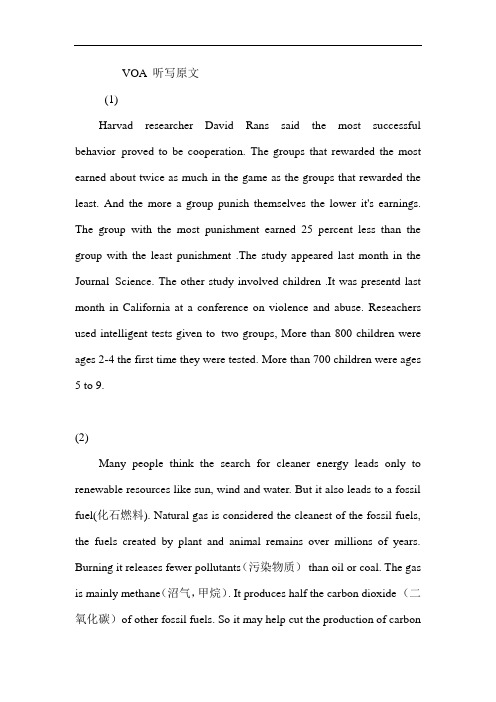
VOA 听写原文(1)Harvad researcher David Rans said the most successful behavior proved to be cooperation. The groups that rewarded the most earned about twice as much in the game as the groups that rewarded the least. And the more a group punish themselves the lower it's earnings. The group with the most punishment earned 25 percent less than the group with the least punishment .The study appeared last month in the Journal Science. The other study involved children .It was presentd last month in California at a conference on violence and abuse. Reseachers used intelligent tests given to two groups, More than 800 children were ages 2-4 the first time they were tested. More than 700 children were ages 5 to 9.(2)Many people think the search for cleaner energy leads only to renewable resources like sun, wind and water. But it also leads to a fossil fuel(化石燃料). Natural gas is considered the cleanest of the fossil fuels, the fuels created by plant and animal remains over millions of years. Burning it releases fewer pollutants(污染物质)than oil or coal. The gas is mainly methane(沼气,甲烷). It produces half the carbon dioxide (二氧化碳)of other fossil fuels. So it may help cut the production of carbongases linked to climate change. Russia is first in what are called "proved reserves" of natural gas. The United States is sixth. Over the years, big oil and gas companies recovered much of the easily reached supplies of gas in America. They drilled straight down into formations where gas collects. As these supplies were used up, big drillers looked for similar formations in other countries.(3)Two recent studies have found that punishment is not the best way to influence behavior. One shows that adults are much more cooperative if they work in a system based on rewards. Researchers at Harward University in the United States and Stockholm school of economics in Sweden did the study. They had about two hundred college students play a version of the game known as the prisoners dilemma. The game is based on the attention between the interests of individual and group. The students play in groups of four. Each player could win points for the group so they would all gain equally. But each player could also reward or punish each of the other three players and cost to the punisher.(4)But now the industry is taking a new look. Companies are developing gas supplies trapped in shale rock two to three thousand meters underground. They drill down to the shale, then go sideways and inject high-pressure water, sand or other material into the rock. This causes therock to break, or fracture, releasing the gas. Huge fields of gas shale are believed to lie under theAppalachian Mountains, Michigan and the south-central states. Gas shale exploration is being done mainly by small to medium sized companies. Eric Potter is a program director in the Bureau of Economic Geology at the University of Texas at Austin.I rememberdo u know that i'm okare there things you wanna saythinking of u night and dayhopping you'll come back and stayi remember when u told mei'll be all rightdon't worryi try and try to understandis all this just a sad goodbyethinking of u night and dayno matter if you'll come and stayi remember when u told mei'll be all rightjust hold mei don't wanna close my eyes tonightmissing u make me cryyour love will give me strengths to carry onyou'll always be my heart and mindso i don't wanna close my eyes tonighti know it's just a miss match in time...why..oh why... miss match in timei try and try to understandis all this just a sad goodbyethinking of u night and dayno matter if you'll come and stayi remember when u told mei'll be all rightjust hold meso i don't wanna close my eyes tonightmissing u make me cryyour love will give me strengths to carry onyou'll always be my heart and mindso i don't wanna close my eyes tonighti know it's just a miss match in time...why..oh why... don't wanna close my eyes tonight.。
group discussion method -回复
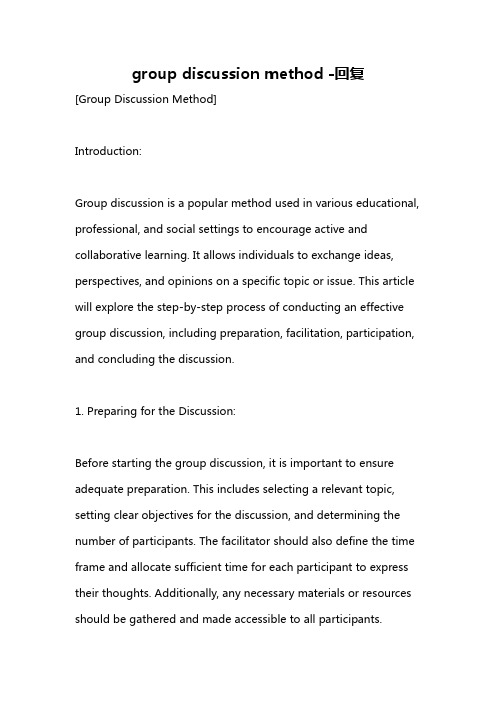
group discussion method -回复[Group Discussion Method]Introduction:Group discussion is a popular method used in various educational, professional, and social settings to encourage active and collaborative learning. It allows individuals to exchange ideas, perspectives, and opinions on a specific topic or issue. This article will explore the step-by-step process of conducting an effective group discussion, including preparation, facilitation, participation, and concluding the discussion.1. Preparing for the Discussion:Before starting the group discussion, it is important to ensure adequate preparation. This includes selecting a relevant topic, setting clear objectives for the discussion, and determining the number of participants. The facilitator should also define the time frame and allocate sufficient time for each participant to express their thoughts. Additionally, any necessary materials or resources should be gathered and made accessible to all participants.2. Introducing the Topic and Establishing Ground Rules:At the beginning of the group discussion, the facilitator should introduce the topic and provide background information to familiarize participants with the subject matter. Clear ground rules should be established to maintain order and ensure respectful communication. This includes guidelines such as allowing each participant to speak without interruption, encouraging active listening, and maintaining a respectful tone throughout the discussion.3. Opening the Discussion:To initiate the discussion, the facilitator can start with anopen-ended question or a brief statement to encourage participants to share their initial thoughts and perspectives. This can help spark ideas and stimulate engagement among the participants. It is essential for the facilitator to actively listen and acknowledge each participant's contribution to create an inclusive environment.4. Encouraging Active Participation:In order to ensure active participation, the facilitator may employ various techniques. One approach is to invite quieter participants to express their thoughts by specifically asking for their input or providing prompts that allow for easy entry into the discussion. Additionally, the facilitator can summarize key points made by participants and encourage others to build upon these ideas. This promotes a sense of collaboration and facilitates a deeper understanding of the topic.5. Managing Differences of Opinion:During group discussions, conflicting viewpoints and differing opinions are common. It is important for the facilitator to manage these differences effectively to avoid escalation or disengagement. Encouraging participants to present evidence or examples to support their arguments can foster a healthy debate. The facilitator may also intervene to mediate the discussion if it becomes heated, ensuring that all participants feel heard and respected.6. Summarizing and Synthesizing Ideas:As the discussion progresses, the facilitator should summarize and synthesize the ideas shared by the participants. This involves highlighting the key points, identifying common themes, and analyzing any new insights that emerged through the discussion. By doing so, the facilitator guides the group towards a collective understanding and facilitates the generation of new ideas.7. Concluding the Discussion:To conclude the group discussion, the facilitator should summarize the main outcomes, key learnings, and possible next steps. This provides closure to the discussion and encourages participants to reflect on their contributions. It is also important to allow time for participants to ask questions or seek clarification on any unresolved issues.8. Follow-up and Reflection:After the discussion, it is beneficial to allow time for individual reflection and provide an opportunity for participants to share their thoughts on the group discussion process. This feedback can helpthe facilitator identify strengths and areas for improvement in order to enhance future group discussions. Additionally, the facilitator may provide additional resources or readings for participants to further explore the topic on their own.Conclusion:The group discussion method is a valuable tool for fostering collaboration, critical thinking, and active learning. By following the step-by-step process outlined above, facilitators can create an inclusive and engaging environment that encourages participants to express their ideas, explore different perspectives, and collectively expand their understanding of the chosen topic.。
分组讨论英语作文
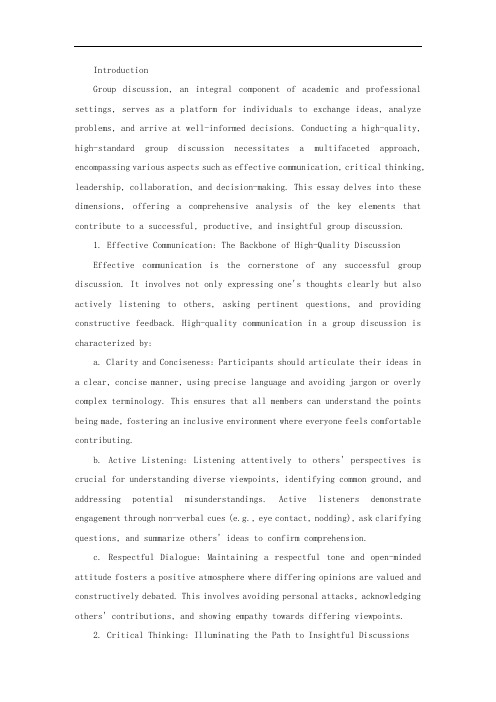
IntroductionGroup discussion, an integral component of academic and professional settings, serves as a platform for individuals to exchange ideas, analyze problems, and arrive at well-informed decisions. Conducting a high-quality, high-standard group discussion necessitates a multifaceted approach, encompassing various aspects such as effective communication, critical thinking, leadership, collaboration, and decision-making. This essay delves into these dimensions, offering a comprehensive analysis of the key elements that contribute to a successful, productive, and insightful group discussion.1. Effective Communication: The Backbone of High-Quality DiscussionEffective communication is the cornerstone of any successful group discussion. It involves not only expressing one's thoughts clearly but also actively listening to others, asking pertinent questions, and providing constructive feedback. High-quality communication in a group discussion is characterized by:a. Clarity and Conciseness: Participants should articulate their ideas in a clear, concise manner, using precise language and avoiding jargon or overly complex terminology. This ensures that all members can understand the points being made, fostering an inclusive environment where everyone feels comfortable contributing.b. Active Listening: Listening attentively to others' perspectives is crucial for understanding diverse viewpoints, identifying common ground, and addressing potential misunderstandings. Active listeners demonstrate engagement through non-verbal cues (e.g., eye contact, nodding), ask clarifying questions, and summarize others' ideas to confirm comprehension.c. Respectful Dialogue: Maintaining a respectful tone and open-minded attitude fosters a positive atmosphere where differing opinions are valued and constructively debated. This involves avoiding personal attacks, acknowledging others' contributions, and showing empathy towards differing viewpoints.2. Critical Thinking: Illuminating the Path to Insightful DiscussionsCritical thinking is the cognitive process of analyzing information, evaluating arguments, and making logical deductions. In a high-standard group discussion, participants must employ critical thinking skills to:a. Identify Key Issues: By discerning the central problem or question at hand, participants can focus the discussion on the most relevant aspects, preventing tangential discussions and ensuring efficient use of time.b. Evaluate Evidence and Arguments: Participants should assess the validity, reliability, and relevance of presented evidence, questioning assumptions, and challenging unsubstantiated claims. This helps to refine ideas, weed out fallacies, and build a robust, evidence-based consensus.c. Generate Creative Solutions: Critical thinkers can apply lateral thinking to generate innovative solutions, considering alternative perspectives and exploring uncharted territories. This contributes to the generation of unique, well-rounded ideas that might not have emerged through individual contemplation.3. Leadership and Facilitation: Steering the Discussion towards ProductivityEffective leadership and facilitation are vital for maintaining the direction, pace, and inclusivity of a high-quality group discussion. Key roles include:a. Setting Clear Objectives: The discussion leader should establish clear, measurable objectives at the outset, outlining the expected outcomes and the steps needed to achieve them. This provides a roadmap for participants, ensuring that the discussion remains focused and purposeful.b. Managing Time and Dynamics: A skilled facilitator will balance the participation of all members, ensuring equal opportunities for contribution while managing potential conflicts or dominant personalities. They will also adhere to the allocated time frame, prioritizing key discussion points and adjusting the agenda if necessary.c. Encouraging Participation and Engagement: Leaders should create an environment where all members feel comfortable sharing their thoughts, askingquestions, and challenging ideas. Techniques such as round-robin brainstorming, small-group activities, or structured debates can promote active participation and foster a sense of ownership among participants.4. Collaboration and Teamwork: Harnessing Collective WisdomEffective collaboration and teamwork are essential for leveraging the diverse expertise, experiences, and perspectives within the group. To achieve high standards in this regard, participants should:a. Recognize and Utilize Individual Strengths: Each member brings unique skills, knowledge, and perspectives to the discussion. Acknowledging and leveraging these strengths can enhance the quality of the discussion and lead to more comprehensive solutions.b. Practice Empathy and Openness: Collaborative discussions thrive when participants demonstrate empathy towards others' viewpoints, even if they differ from their own. An open-minded approach fosters mutual respect, encourages constructive dialogue, and facilitates the synthesis of diverse ideas.c. Foster Trust and Accountability: Trust is vital for establishing a safe space where members feel comfortable sharing their thoughts and taking risks. This can be achieved through transparency, follow-through on commitments, and recognition of individual contributions. A culture of accountability ensures that all members are invested in the success of the discussion and committed to achieving the agreed-upon objectives.5. Decision-Making: Converting Discussion into Actionable OutcomesA high-standard group discussion culminates in well-informed, consensus-driven decisions that address the identified issues effectively. This involves:a. Summarizing Key Points and Consensus: Toward the end of the discussion, the facilitator or a designated member should summarize the main points discussed, highlighting areas of agreement and disagreement. This helps to crystallize the group's thinking and ensures that everyone has a shared understanding of the key takeaways.b. Establishing Criteria for Decision-Making: If a decision is required, the group should agree on the criteria for evaluation, such as feasibility, impact, cost-effectiveness, or alignment with organizational values. This promotes transparency and fairness in the decision-making process.c. Voting, Consensus-Building, or Compromise: Depending on the group's preference and the nature of the decision, various decision-making methods can be employed. These may include majority vote, seeking unanimous consent, or reaching a compromise that satisfies the core concerns of all parties involved.ConclusionIn conclusion, conducting a high-quality, high-standard group discussion necessitates a multi-faceted approach that encompasses effective communication, critical thinking, leadership, collaboration, and decision-making. By focusing on these dimensions, participants can harness the collective wisdom of the group, foster a positive and inclusive atmosphere, and arrive at well-informed, actionable outcomes. Ultimately, such discussions not only enhance problem-solving capabilities but also promote personal and professional growth, strengthening the bonds among team members and fostering a culture of continuous learning and improvement.。
小组讨论作用英语作文高中

Group discussions are an integral part of the educational experience, especially in high school where students are encouraged to develop critical thinking and communication skills. In my high school years, I have participated in numerous group discussions that have not only enriched my understanding of various subjects but also helped me grow as an individual.One of the most significant benefits of group discussions is the opportunity to learn from the diverse perspectives of my peers. Each person brings a unique viewpoint to the table, which can lead to a more comprehensive understanding of the topic at hand. For instance, during a discussion on environmental conservation, one of my classmates shared her experience volunteering at a local wildlife reserve. Her firsthand account of the challenges faced by the ecosystem provided a new dimension to our understanding of the issue, which we might not have considered otherwise.Moreover, group discussions foster a sense of collaboration and teamwork. Working together towards a common goal teaches us the importance of effective communication and compromise. In one of our English literature classes, we were tasked with analyzing a complex play. By discussing the characters, themes, and motifs, we were able to dissect the text more thoroughly than we could have individually. It was a testament to the power of collective effort and the value of each persons contribution.Another advantage of group discussions is the development of critical thinking skills. Engaging in debates and exchanging ideas with myclassmates has taught me to question assumptions and consider alternative interpretations. This skill is not only valuable in an academic context but also in everyday life, where it is crucial to make informed decisions.Furthermore, group discussions have helped me improve my public speaking and presentation skills. As a naturally introverted person, I initially found it challenging to express my thoughts in front of a group. However, with practice and encouragement from my peers, I gradually became more confident in voicing my opinions. This newfound confidence has not only benefited me academically but also in social situations where clear communication is essential.In addition to these benefits, group discussions also provide a platform for students to practice empathy and understanding. By listening to the opinions and experiences of others, we learn to appreciate different perspectives and develop a more openminded approach to problemsolving.However, group discussions are not without their challenges. Sometimes, conflicts may arise due to differing opinions or personality clashes. In such situations, it is crucial to maintain respect for one another and strive for a constructive resolution. Overcoming these obstacles can be a valuable learning experience, teaching us the importance of patience and diplomacy.In conclusion, group discussions play a vital role in the high schoolexperience. They offer a dynamic learning environment where students can develop essential skills such as critical thinking, communication, and collaboration. Despite the occasional challenges, the benefits of group discussions far outweigh the drawbacks, making them an indispensable part of our educational journey. As I reflect on my high school years, I am grateful for the countless group discussions that have shaped my understanding of the world and contributed to my personal growth.。
英语单词详解系列[高中人教选修7单元1]七十三
![英语单词详解系列[高中人教选修7单元1]七十三](https://img.taocdn.com/s3/m/8c0eb229a26925c52dc5bf03.png)
英语单词详解系列[高中人教选修7单元1]七十三Barry释义_ _ _ _ _ _ _ _ _ _ _ _ _ _ _ _ _ _ _ _ _ __ _ _ _ _ _ _ _ _ _ _ _ _ _ _ _ _ _ _ _ _ _ _ _ _ _ _ n. 巴里(男子名)短语_ _ _ _ _ _ _ _ _ _ _ _ _ _ _ _ _ _ _ _ _ __ _ _ _ _ _ _ _ _ _ _ _ _ _ _ _ _ _ _ _ _ _ _ _ _ _ _ Barry County:巴里县Barry Marshall:巴里·马歇尔;马歇尔;马绍尔Barry Goldwater:巴里·戈德华特;高华德;德沃特;戈德华特Barry Buzan:巴瑞·布赞;巴里·布赞;巴利·博赞;巴瑞·博赞Barry Lam:林百里;董事长林百里Barry Allen:巴里·艾伦;闪电侠;巴里·阿伦;格兰特·古斯汀Barry Cottle:科特尔;柯特勒;考特尔Barry Callebaut:嘉利宝;百乐;宝公司Barry Eichengreen:巴里·艾肯格林;易臣格瑞;艾青格林;巴瑞·易臣格瑞例句_ _ _ _ _ _ _ _ _ _ _ _ _ _ _ _ _ _ _ _ _ __ _ _ _ _ _ _ _ _ _ _ _ _ _ _ _ _ _ _ _ _ _ _ _ _ _ _1.N a mistake or blunder; a disappointing performance 错误; 令人失望的表演[AUSTRALIAN] [slang]community音标_ _ _ _ _ _ _ _ _ _ _ _ _ _ _ _ _ _ _ _ _ __ _ _ _ _ _ _ _ _ _ _ _ _ _ _ _ _ _ _ _ _ _ _ _ _ _ _ 英[kəˈmju:nətɪ] 美[kəˈmjunətɪ]附加_ _ _ _ _ _ _ _ _ _ _ _ _ _ _ _ _ _ _ _ _ __ _ _ _ _ _ _ _ _ _ _ _ _ _ _ _ _ _ _ _ _ _ _ _ _ _ _ [ 复数communities ]释义_ _ _ _ _ _ _ _ _ _ _ _ _ _ _ _ _ _ _ _ _ __ _ _ _ _ _ _ _ _ _ _ _ _ _ _ _ _ _ _ _ _ _ _ _ _ _ _ n. 社区;[生态] 群落;共同体;团体短语_ _ _ _ _ _ _ _ _ _ _ _ _ _ _ _ _ _ _ _ _ __ _ _ _ _ _ _ _ _ _ _ _ _ _ _ _ _ _ _ _ _ _ _ _ _ _ _ international community:国际社会;国际共同体;国际社区;英语交流区Taizé Community:泰泽团体community development:社区发展;地区开发;群落发生Community counseling:社区谘商;社区咨询;社会咨询;就读社区咨询DONGFENG community:东风社区Community Medicine:社区医学部;Community Times:社区医学;社会医学Community Center:公益时报例句_ _ _ _ _ _ _ _ _ _ _ _ _ _ _ _ _ _ _ _ _ __ _ _ _ _ _ _ _ _ _ _ _ _ _ _ _ _ _ _ _ _ _ _ _ _ _ _1.N-SING-COLL The community is all the people who live in a particular area or place. 社区例:He’s well liked by people in the community.他很受社区人们的喜爱。
超激光物理因子治疗小儿跟腱延长术后脑瘫患儿的镇痛效果研究
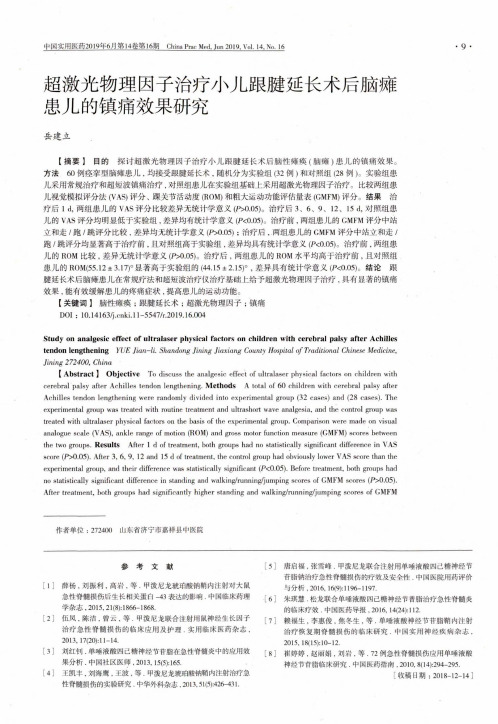
超激光物理因子治疗小儿跟腱延长术后脑瘫患儿的镇痛效果研究岳建立【摘要】目的探讨超激光物理因子治疗小儿跟腱延长术后脑性瘫痪(脑瘫)患儿的镇痛效果。
方法60例痉挛型脑瘫患儿,均接受跟腱延长术.随机分为实验组(32例)和对照组(28例)。
实验组患儿采用常规治疗和超短波镇痛治疗,对照组患儿在实验组基础上采用超激光物理因子治疗。
比较两组患儿视觉模拟评分法(VAS)评分、踝关节活动度(ROM)和粗大运动功能评估量表(GMFM)评分。
结果治疗后1d,两组患儿的VAS评分比较差异无统计学意义(P>0.05)。
治疗后3、6、9、12、15d,对照组患儿的VAS评分均明显低于实验组,差异均有统计学意义(P<0.05)o治疗前,两组患儿的GMFM评分中站立和走/跑/跳评分比较,差异均无统计学意义(P>0.05);治疗后,两组患儿的GMFM评分中站立和走/跑/跳评分均显著高于治疗前,且对照组高于实验组,差异均具有统计学意义(P<0.05)。
治疗前,两组患儿的ROM比较,差异无统计学意义(P>0.05)o治疗后,两组患儿的ROM水平均高于治疗前,且对照组患儿的ROM(55.12±3.17)°显著高于实验组的(44.15±2.15)°,差异具有统计学意义(P<0.05)。
结论跟腱延长术后脑瘫患儿在常规疗法和超短波治疗仪治疗基础上给予超激光物理因子治疗,具有显著的镇痛效果,能有效缓解患儿的疼痛症状,提高患儿的运动功能。
【关键词】脑性瘫痪;跟腱延长术;超激光物理因子;镇痛D0I:10.14163/ki.ll-5547/r.2019.16.004Study on analgesic effect of ultralaser physical factors on children with cerebral palsy after Achilles tendon lengthening YUE Jian-li.Shandong Jining Jiaxiang County Hospital of Traditional Chinese Medicine, lining272400,China[Abstract]Objective To discuss the analgesic effect of ultralaser physical factors on children with cerebral palsy after Achilles tendon lengthening.Methods A total of60children with cerebral palsy after Achilles tendon lengthening were randomly divided into experimental group(32cases)and(28cases).The experimental group was treated with routine treatment and ultrashort wave analgesia,and the control group was treated with ultralaser physical factors on the basis of the experimental parison were made on visual analogue scale(VAS),ankle range of motion(ROM)and gross motor function measure(GMFM)scores between the two groups.Results After1d of treatment,both groups had no statistically significant difference in VAS score(P>0.05).After3,6,9,12and15d of treatment,the control group had obviously lower VAS score than the experimental group,and their difference was statistically significant(Pv0.05).Before treatment,both groups had no statistically significant difference in standing and walking/running/jumping scores of GMFM scores(P>0.05). After treatment,both groups had significantly higher standing and walking/running/jumping scores of GMFM作者单位:272400山东省济宁市嘉祥县中医院参考文献[5][1]薛杨,刘振利,高岩,等•甲泼尼龙琥珀酸钠鞘内注射对大鼠急性脊髓损伤后生长相关蛋白-43表达的影响•中国临床药理[6]学杂志,2015,21(8):1866-1868.[2]伍凤,陈洁,曾云,等.甲泼尼龙联合注射用鼠神经生长因子[7]治疗急性脊髓损伤的临床应用及护理.实用临床医药杂志,2013,17(20):11-14.[3]刘红钊.单唾液酸四己糖神经节昔脂在急性脊髓炎中的应用效[8]果分析.中国社区医师,2013,15(5):165.[4]王凯丰,刘海鹰,王波,等.甲泼尼龙琥珀酸钠鞘内注射治疗急性脊髓损伤的实验研究•中华外科杂志,2013,51(5):426-431.唐启福•张雪峰•甲泼尼龙联合注射用单唾液酸四己糖神经节昔脂钠治疗急性脊髓损伤的疗效及安全性•中国医院用药评价与分析,2016,16(9):1196-1197.朱琪慧•松龙联合单唾液酸四己糖神经节普脂治疗急性脊髓炎的临床疗效•中国医药导报,2016,14(24):112.赖福生,李惠俊,焦冬生,等.单唾液酸神经节昔脂鞘内注射治疗恢复期脊髓损伤的临床研究.中国实用神经疾病杂志,2015,18(15):10-12.崔婷婷,赵丽娟,刘岩,等.72例急性脊髓损伤应用单唾液酸神经节昔脂临床研究.中国医药指南,2010,8(14):294-295.[收稿日期:2018-12-14]scores,and the control group was higher than the experimental group.Their difference was statistically significant (P<0.05).Before treatment,both groups had no statistically significant difference in ROM(P>0.05).After treatment,both groups had higher ROM than that before treatment,and the control group had significantly higher ROM as(55」2±3.17)°than(44.15±2.15)°in experimental group.Their difference was statistically significant (P<0.05).Conclusion For children with cerebral palsy after Achilles tendon lengthening,ultralaser physical factors on the basis of conventional therapy and ultrashort wave therapy has significant analgesic effect,and can effectively alleviate the pain symptoms of children and improve their motor function.【Key words】Cerebral palsy;Achilles tendon lengthening;Ultralaser physical factors;Analgesic痉挛型脑瘫是一种常见的患儿脑瘫类型。
关于小组讨论手抄报的英语作文
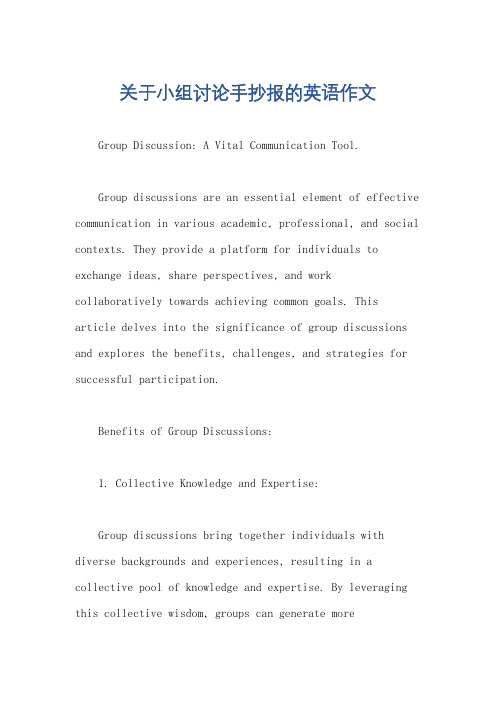
关于小组讨论手抄报的英语作文Group Discussion: A Vital Communication Tool.Group discussions are an essential element of effective communication in various academic, professional, and social contexts. They provide a platform for individuals to exchange ideas, share perspectives, and workcollaboratively towards achieving common goals. Thisarticle delves into the significance of group discussions and explores the benefits, challenges, and strategies for successful participation.Benefits of Group Discussions:1. Collective Knowledge and Expertise:Group discussions bring together individuals with diverse backgrounds and experiences, resulting in a collective pool of knowledge and expertise. By leveraging this collective wisdom, groups can generate morecomprehensive solutions and make informed decisions.2. Enhanced Creativity and Innovation:The exchange of different viewpoints and perspectives fosters a stimulating environment that sparks creativityand innovation. Individuals are encouraged to challenge assumptions, explore new ideas, and think outside the box.3. Improved Decision-Making:Group discussions allow for a thorough examination of issues from multiple angles. By considering various perspectives, groups can reach well-rounded decisions that are more likely to be effective and supported by all members.4. Development of Communication Skills:Group discussions provide an excellent opportunity to practice and develop communication skills, such as active listening, respectful dialogue, and persuasive presentation.Participants learn to articulate their thoughts clearly, respond to others, and engage in constructive conversations.5. Relationship Building and Consensus:Collaborative discussions help foster relationships among group members as they work towards a shared goal. Through open communication and compromise, groups can build consensus and create a sense of unity.Challenges of Group Discussions:1. Domination and Participation Imbalance:In some groups, certain individuals may dominate the discussion, while others may remain hesitant to participate. This can hinder the sharing of all perspectives and limitthe effectiveness of the discussion.2. Conflicts and Disagreements:Diverse perspectives can sometimes lead to conflictsand disagreements within the group. It is crucial to manage these conflicts constructively, ensuring that they do not derail the discussion and prevent progress.3. Time Constraints:Group discussions are often constrained by time limits, which can limit the depth of exploration and prevent thorough decision-making. Effective time management techniques are essential to maximize the use of available time.Strategies for Successful Group Participation:1. Preparation:Thoroughly research the topic and come prepared to contribute informed perspectives. This will enhance your credibility and ensure that your contributions are valuable.2. Active Listening:Pay attention to what others are saying, ask clarifying questions, and demonstrate that you are genuinelyinterested in their ideas. Active listening fosters a respectful atmosphere and promotes understanding.3. Constructive Feedback:Provide constructive feedback to others, focusing on the content of their ideas rather than personal attacks. Respectful feedback helps improve the quality of the discussion and encourages a collaborative environment.4. Collaboration and Compromise:Work collaboratively with other group members, finding common ground and areas of agreement. Be willing to compromise and find solutions that accommodate multiple perspectives.5. Clear Communication:Articulate your thoughts clearly and concisely. Usespecific examples and avoid jargon to ensure that you are easily understood by all participants.Conclusion:Group discussions are a powerful communication tool that offer numerous benefits, including collective knowledge, enhanced creativity, improved decision-making, and relationship building. While there are challenges to consider, such as domination, conflicts, and time constraints, effective strategies can maximize the success of group discussions. By preparing, actively listening, providing constructive feedback, collaborating, and communicating clearly, individuals can contribute effectively to group discussions and achieve shared goals.。
高考英语 分组讨论 作文
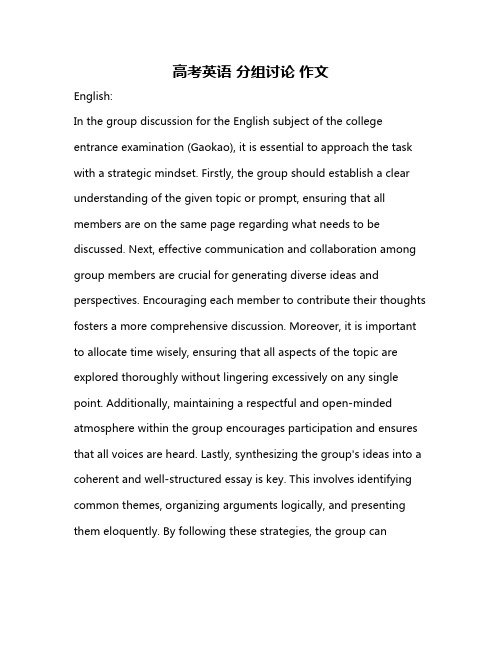
高考英语分组讨论作文English:In the group discussion for the English subject of the college entrance examination (Gaokao), it is essential to approach the task with a strategic mindset. Firstly, the group should establish a clear understanding of the given topic or prompt, ensuring that all members are on the same page regarding what needs to be discussed. Next, effective communication and collaboration among group members are crucial for generating diverse ideas and perspectives. Encouraging each member to contribute their thoughts fosters a more comprehensive discussion. Moreover, it is important to allocate time wisely, ensuring that all aspects of the topic are explored thoroughly without lingering excessively on any single point. Additionally, maintaining a respectful and open-minded atmosphere within the group encourages participation and ensures that all voices are heard. Lastly, synthesizing the group's ideas into a coherent and well-structured essay is key. This involves identifying common themes, organizing arguments logically, and presenting them eloquently. By following these strategies, the group canmaximize its potential for success in the group discussion portion of the English Gaokao.中文翻译:在高考英语科目的分组讨论中,以战略思维来完成任务至关重要。
展示小组讨论结果的英语发言稿 英语

展示小组讨论结果的英语发言稿英语Ladies and gentlemen,Good afternoon. I am pleased to present to you the results of our group discussion on the topic of climate change and its impact on the environment. Our group consisted of five members who are all passionate about environmental sustainability and eager to make a positive change in the world.During our discussion, we explored various aspects of climate change, including the causes, consequences, and potential solutions. We agreed that human activities, such as deforestation, burning of fossil fuels, and industrial emissions, are the primary drivers of climate change. These activities have led to a rise in global temperatures, melting ice caps, rising sea levels, and more frequent extreme weather events.We also discussed the impacts of climate change on the environment, including loss of biodiversity, habitat destruction, and increased pollution. We recognized the urgent need for action to mitigate the effects of climate change and protect our planet for future generations.In terms of solutions, our group proposed several recommendations for individuals, communities, andgovernments to address climate change. These include reducing carbon emissions, transitioning to renewable energy sources, promoting sustainable practices, and advocating for policy changes at the local, national, and international levels.Overall, our group discussion was productive and insightful, and we believe that by working together and taking action, we can make a positive impact in the fight against climate change. Thank you for your attention, and we look forward to continuing the conversation and taking concrete steps towards a more sustainable future.Thank you.。
我们正在讨论班会英文作文
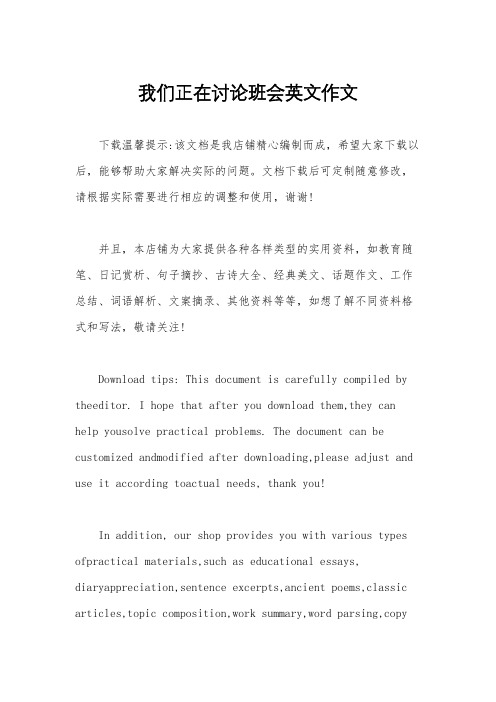
我们正在讨论班会英文作文下载温馨提示:该文档是我店铺精心编制而成,希望大家下载以后,能够帮助大家解决实际的问题。
文档下载后可定制随意修改,请根据实际需要进行相应的调整和使用,谢谢!并且,本店铺为大家提供各种各样类型的实用资料,如教育随笔、日记赏析、句子摘抄、古诗大全、经典美文、话题作文、工作总结、词语解析、文案摘录、其他资料等等,如想了解不同资料格式和写法,敬请关注!Download tips: This document is carefully compiled by theeditor. I hope that after you download them,they can help yousolve practical problems. The document can be customized andmodified after downloading,please adjust and use it according toactual needs, thank you!In addition, our shop provides you with various types ofpractical materials,such as educational essays, diaryappreciation,sentence excerpts,ancient poems,classic articles,topic composition,work summary,word parsing,copyexcerpts,other materials and so on,want to know different data formats andwriting methods,please pay attention!Good morning, everyone! Today, I want to talk about our class meeting. It was quite an interesting one, filled with lively discussions and diverse opinions. 。
群体研究的英语作文
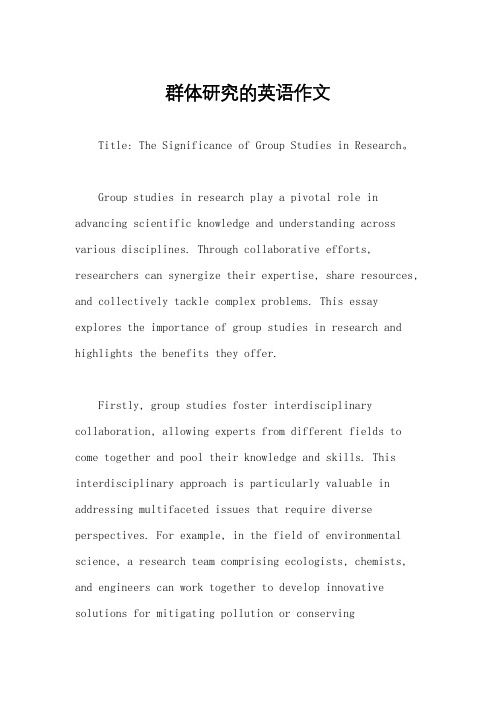
群体研究的英语作文Title: The Significance of Group Studies in Research。
Group studies in research play a pivotal role in advancing scientific knowledge and understanding across various disciplines. Through collaborative efforts, researchers can synergize their expertise, share resources, and collectively tackle complex problems. This essay explores the importance of group studies in research and highlights the benefits they offer.Firstly, group studies foster interdisciplinary collaboration, allowing experts from different fields to come together and pool their knowledge and skills. This interdisciplinary approach is particularly valuable in addressing multifaceted issues that require diverse perspectives. For example, in the field of environmental science, a research team comprising ecologists, chemists, and engineers can work together to develop innovative solutions for mitigating pollution or conservingbiodiversity.Moreover, group studies promote creativity and innovation by fostering a culture of brainstorming and idea generation. In a collaborative setting, researchers can freely exchange ideas, challenge assumptions, and explore unconventional approaches. This collaborative environment stimulates creativity and often leads to breakthrough discoveries that might not have been possible through individual efforts alone. For instance, the development of new medical treatments or technologies often involves interdisciplinary teams working collaboratively to push the boundaries of knowledge.Furthermore, group studies enhance the quality and reliability of research findings through peer review and collective scrutiny. When multiple researchers examine and critique each other's work, they can identify errors, biases, and limitations more effectively. This rigorous peer review process helps ensure the accuracy and validity of research outcomes, thereby enhancing the credibility of the scientific community. Additionally, collaborativeresearch projects often involve replication studies conducted by independent teams, which further validate the robustness of the findings.In addition to advancing scientific knowledge, group studies also provide valuable learning opportunities for researchers, especially early-career scientists and students. By participating in collaborative research projects, individuals can gain hands-on experience, develop critical thinking skills, and expand their professional networks. Moreover, working in a team environment fosters interpersonal skills such as communication, teamwork, and leadership, which are essential for success in both academia and industry.Furthermore, group studies facilitate the efficient use of resources by leveraging shared infrastructure, equipment, and funding. By pooling resources, research teams canaccess specialized facilities and technologies that mightbe beyond the reach of individual researchers. This collaborative approach not only maximizes the impact of limited resources but also promotes cost-effectiveness andsustainability in research endeavors.In conclusion, group studies play a crucial role in advancing scientific research by promotinginterdisciplinary collaboration, fostering creativity and innovation, enhancing the quality and reliability of research findings, providing learning opportunities, and maximizing the efficient use of resources. By working together in collaborative teams, researchers can address complex challenges more effectively and accelerate the pace of discovery and innovation across various fields. As we continue to tackle global issues and pursue new frontiers of knowledge, the importance of group studies in research will only continue to grow.。
对课堂教学分组讨论看法的英语作文
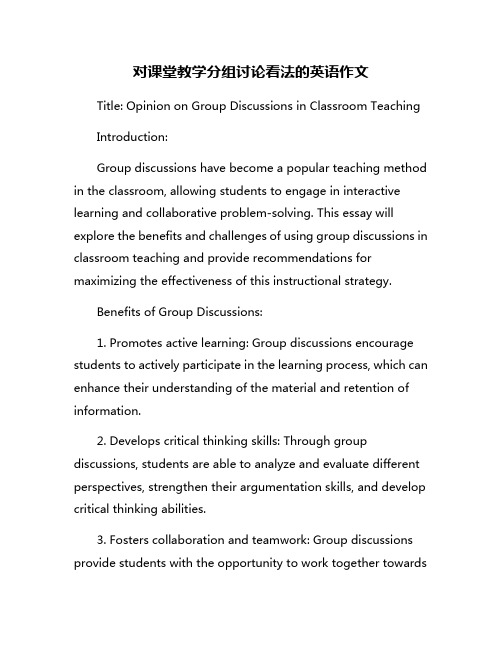
对课堂教学分组讨论看法的英语作文Title: Opinion on Group Discussions in Classroom TeachingIntroduction:Group discussions have become a popular teaching method in the classroom, allowing students to engage in interactive learning and collaborative problem-solving. This essay will explore the benefits and challenges of using group discussions in classroom teaching and provide recommendations for maximizing the effectiveness of this instructional strategy.Benefits of Group Discussions:1. Promotes active learning: Group discussions encourage students to actively participate in the learning process, which can enhance their understanding of the material and retention of information.2. Develops critical thinking skills: Through group discussions, students are able to analyze and evaluate different perspectives, strengthen their argumentation skills, and develop critical thinking abilities.3. Fosters collaboration and teamwork: Group discussions provide students with the opportunity to work together towardsa common goal, promoting collaboration and teamwork skills that are essential for success in the workplace.4. Increases student engagement: By involving students in discussions and allowing them to share their thoughts and opinions, teachers can increase student engagement and create a more dynamic and interactive learning environment.Challenges of Group Discussions:1. Unequal participation: In group discussions, some students may dominate the conversation, while others may be reluctant to speak up. This can lead to unequal participation and limit the effectiveness of the discussion.2. Lack of preparation: Students may come to group discussions unprepared, resulting in a lack of meaningful contributions and a loss of focus during the discussion.3. Time constraints: Group discussions can betime-consuming, especially if the group is large or if the discussion goes off track. This can make it difficult to cover all the material that needs to be addressed during the class session.4. Conflicts and disagreements: Group discussions can sometimes lead to conflicts and disagreements among students,which can disrupt the learning process and hinder the achievement of the learning objectives.Recommendations for Maximizing Effectiveness:1. Establish clear guidelines: Provide students with clear guidelines for participating in group discussions, such as expectations for preparation, participation, and respectful communication.2. Monitor participation: Be mindful of student participation during group discussions and intervene as needed to ensure that all students have the opportunity to contribute and that the discussion remains focused.3. Provide feedback: Offer constructive feedback to students on their participation in group discussions, highlighting their strengths and areas for improvement to help them enhance their communication and critical thinking skills.4. Incorporate group discussions strategically: Use group discussions strategically to reinforce key concepts, promote student engagement, and encourage active learning, while also recognizing the limitations and challenges of this instructional method.Conclusion:Overall, group discussions can be a valuable tool for enhancing classroom teaching and promoting active learning, critical thinking, collaboration, and student engagement. By addressing the challenges and implementing strategies for maximizing effectiveness, teachers can harness the power of group discussions to create a dynamic and interactive learning environment that fosters student success.。
对课堂教学分组讨论看法的英语作文
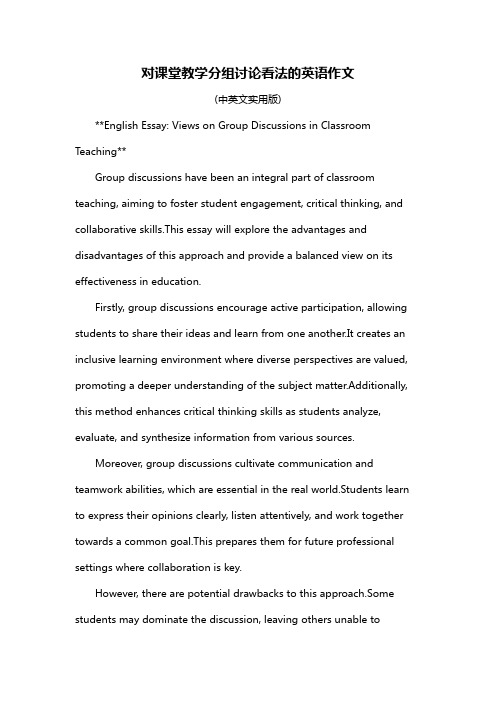
对课堂教学分组讨论看法的英语作文(中英文实用版)**English Essay: Views on Group Discussions in Classroom Teaching**Group discussions have been an integral part of classroom teaching, aiming to foster student engagement, critical thinking, and collaborative skills.This essay will explore the advantages and disadvantages of this approach and provide a balanced view on its effectiveness in education.Firstly, group discussions encourage active participation, allowing students to share their ideas and learn from one another.It creates an inclusive learning environment where diverse perspectives are valued, promoting a deeper understanding of the subject matter.Additionally, this method enhances critical thinking skills as students analyze, evaluate, and synthesize information from various sources.Moreover, group discussions cultivate communication and teamwork abilities, which are essential in the real world.Students learn to express their opinions clearly, listen attentively, and work together towards a common goal.This prepares them for future professional settings where collaboration is key.However, there are potential drawbacks to this approach.Some students may dominate the discussion, leaving others unable tocontribute effectively.This can lead to inequality in participation and hinder the learning experience for quieter students.Furthermore, group discussions may deviate from the main topic, causing a lack of focus and potentially wasting valuable classroom time.Another concern is the potential for social loafing, where some students may rely on others to do the work, resulting in an unequal distribution of effort.This can compromise the integrity of the group"s output and undermine the learning process.In conclusion, while group discussions offer numerous benefits, they must be implemented thoughtfully.Teachers should establish clear guidelines, encourage equal participation, and monitor the discussions to ensure they remain on track.By doing so, group discussions can be a powerful tool in promoting student engagement, critical thinking, and collaborative skills, ultimately enhancing the overall quality of education.**中文作文:关于课堂教学分组讨论的看法**分组讨论已经成为课堂教学的重要组成部分,旨在促进学生的参与度、批判性思维和协作能力。
英语课堂上小组讨论的操作

英语课堂上小组讨论的操作Here is the English essay on the topic "Group Discussion Operations in the English Classroom" with over 1000 words in the main text:Group Discussion Operations in the English ClassroomLearning a new language can be a daunting task for many students but an essential one in today's globalized world. One of the most effective methods to improve language proficiency is through group discussions in the classroom setting. Group discussions not only help students practice their speaking and listening skills but also foster critical thinking and teamwork abilities. In this essay I will explore the key aspects of group discussion operations in the English classroom and how they can contribute to the overall language learning process.Firstly, the formation of effective groups is crucial for productive discussions. Instructors should carefully consider factors such as language proficiency levels, personalities, and learning styles when assigning students to small groups. Ideally groups should be heterogeneous with a mix of strong and weaker students. This allows more proficient learners to provide support and guidance to theirpeers thereby improving the learning outcomes for the entire group. Group size is also an important factor to consider with four to six students being an optimal number. Groups that are too large can become unwieldy and inhibit individual participation while groups that are too small may lack the diverse perspectives needed for robust discussions.Another key aspect is the choice of discussion topics. Instructors should select themes and tasks that are relevant engaging and appropriately challenging for the learners. Topics that are too simple will not stimulate critical thinking while overly complex topics may overwhelm students and discourage participation. A good strategy is to provide a range of discussion prompts that allow students to draw on their personal experiences and opinions. This not only makes the discussions more interesting but also gives quieter students an opportunity to share their unique perspectives. Instructors should also consider incorporating current events and real-world issues into the discussions as they can foster a deeper understanding of the language and cultivate global citizenship.The role of the instructor in facilitating group discussions is also crucial. While the discussions should be student-led the instructor needs to provide guidance and structure to ensure the conversations remain productive. This may involve setting clear expectations and ground rules providing feedback and redirecting the discussionwhen necessary. Instructors should also circulate among the groups observing the discussions and offering assistance when needed. By taking on more of a facilitator role rather than a lecturer the instructor can encourage students to take ownership of their learning and develop greater autonomy.In addition to the instructor's facilitation skills the physical classroom environment can also impact the effectiveness of group discussions. Ideally the classroom should be arranged to promote collaboration with movable desks or tables that allow students to face each other. Sufficient space should also be provided for students to move around and engage in activities. The use of technology such as presentation software or online collaboration tools can also enhance the discussions by providing visual aids and allowing students to share and build on each other's ideas in real-time.Finally the assessment and feedback processes are crucial for reinforcing the language skills developed through group discussions. Instructors should provide both formative and summative assessments that evaluate not only the content of the discussions but also the language skills demonstrated by the students. This may include grading participation, monitoring progress on specific language objectives, and providing constructive feedback on areas for improvement. Peer feedback can also be a valuable tool allowing students to learn from each other and develop self-reflection skills.In conclusion group discussions play a vital role in the English language classroom by providing students with valuable opportunities to practice and improve their communication skills. From the formation of effective groups to the selection of engaging discussion topics and the instructor's facilitation role each element contributes to the overall success of this pedagogical approach. When implemented effectively group discussions can foster a collaborative and supportive learning environment where students feel empowered to take risks express their ideas and continuously develop their English language proficiency.。
为了小组的集体该做作文题目
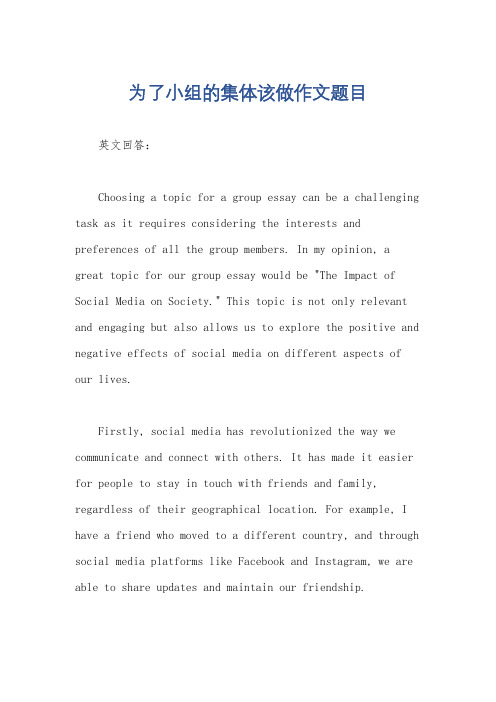
为了小组的集体该做作文题目英文回答:Choosing a topic for a group essay can be a challenging task as it requires considering the interests and preferences of all the group members. In my opinion, a great topic for our group essay would be "The Impact of Social Media on Society." This topic is not only relevant and engaging but also allows us to explore the positive and negative effects of social media on different aspects of our lives.Firstly, social media has revolutionized the way we communicate and connect with others. It has made it easier for people to stay in touch with friends and family, regardless of their geographical location. For example, I have a friend who moved to a different country, and through social media platforms like Facebook and Instagram, we are able to share updates and maintain our friendship.On the other hand, social media has also brought about some negative consequences. One example is the issue of cyberbullying. With the anonymity provided by social media, some individuals feel empowered to harass and intimidate others online. This can have severe psychological effectson the victims. I personally know someone who experienced cyberbullying, and it greatly affected their self-esteemand mental well-being.中文回答:选择一个小组作文的题目对于我们来说是一个具有挑战性的任务,因为它需要考虑到所有小组成员的兴趣和喜好。
因为外教分组不合理提出建议的英语作文
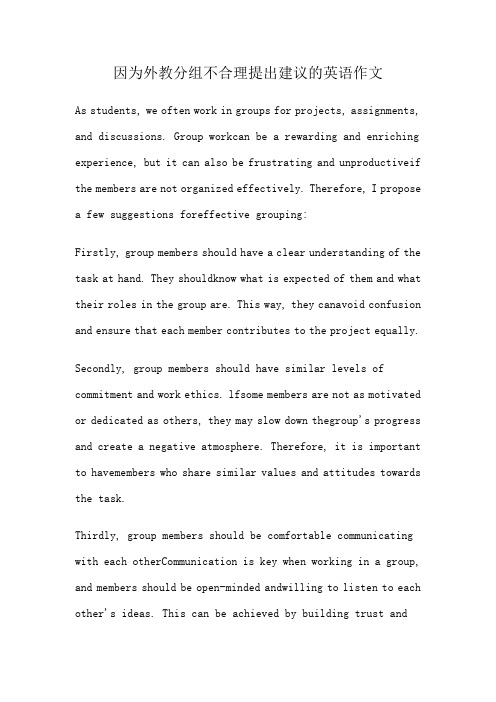
因为外教分组不合理提出建议的英语作文As students, we often work in groups for projects, assignments, and discussions. Group workcan be a rewarding and enriching experience, but it can also be frustrating and unproductiveif the members are not organized effectively. Therefore, I propose a few suggestions foreffective grouping:Firstly, group members should have a clear understanding of the task at hand. They shouldknow what is expected of them and what their roles in the group are. This way, they canavoid confusion and ensure that each member contributes to the project equally. Secondly, group members should have similar levels of commitment and work ethics. lfsome members are not as motivated or dedicated as others, they may slow down thegroup's progress and create a negative atmosphere. Therefore, it is important to havemembers who share similar values and attitudes towards the task.Thirdly, group members should be comfortable communicating with each otherCommunication is key when working in a group, and members should be open-minded andwilling to listen to each other's ideas. This can be achieved by building trust andcreating arespectful atmosphere.Finally, groups should establish a clear timeline and schedule for completing the task. Thiswill help to keep the group on track and ensure that all members are aware of upcomingdeadlines.Setting clear goals and regular check-ins can also help to preventmisunderstandings and keep everyone on the same page.in conclusion, effective grouping requires clear communication, commitment, understandingand a clear timeline. By following these suggestions, groups can work more efficiently andachieve better results.。
他总是安静的写作业英语

He always works on his homework quietly.He prefers a peaceful environment to concentrate better on his tasks,which often involves reading,writing,and solving problems.His quiet demeanor while doing homework helps him to focus deeply on the subject matter,ensuring that he understands and retains the information effectively. When he is at home,he usually chooses a quiet corner or his room where there are minimal distractions.He might use headphones to block out any noise from the outside, creating a personal sanctuary for studying.His workspace is typically organized and clean,with all the necessary materials within reach,such as textbooks,notebooks,pens, and a computer if needed for research.In school,he might opt to find a quiet spot in the library or an empty classroom during breaks or after classes to complete his assignments.He appreciates the quiet atmosphere that these places provide,allowing him to work without interruptions.His quiet approach to homework also means that he is less likely to be disturbed by others,which is important for maintaining his concentration.He might take short breaks to rest his eyes or stretch his body,but he always returns to his work with renewed focus. He understands the importance of time management and often sets aside specific hours for homework each day.This routine helps him to balance his academic responsibilities with other activities,such as sports,hobbies,or socializing with friends.In group projects,he is a valuable team member because of his ability to listen attentively and contribute thoughtfully to discussions.His quiet nature allows him to process information and ideas thoroughly before sharing them with the group.Overall,his quiet approach to homework is a reflection of his personality and learning style.It enables him to work efficiently and effectively,leading to better academic performance and a deeper understanding of the subjects he studies.。
保护动物建议作文英语

Protecting animals is a crucial aspect of environmental conservation and a responsibility that each of us should take seriously.Here are some suggestions on how we can contribute to the preservation of animal species and their habitats:1.Raise Awareness:Educate yourself and others about the importance of animal conservation.Share information through social media,community events,and school programs to increase public understanding of the challenges faced by various species.2.Support Conservation Organizations:Donate to or volunteer with organizations that work to protect endangered species and their habitats.These groups often rely on public support to fund their efforts.3.Adopt Sustainable Practices:Choose products that are made with sustainable materials and support companies that prioritize environmental responsibility.This includes reducing the use of singleuse plastics,which can harm marine life.4.Respect Wildlife:When visiting natural areas,observe wildlife from a distance and avoid disturbing their habitats.Do not feed wild animals,as this can disrupt their natural behaviors and diets.5.Promote Biodiversity:Support policies and initiatives that protect and restore ecosystems,which are essential for the survival of many animal species.This can include supporting the creation of wildlife corridors and protected areas.6.Reduce Your Carbon Footprint:Climate change is a significant threat to many animal species.By reducing your carbon footprint through energy conservation,using renewable energy sources,and reducing waste,you can help mitigate this threat.7.Support Ethical Tourism:When traveling,choose tours and activities that respect local wildlife and ecosystems.Avoid attractions that exploit animals for entertainment,such as dolphin shows or elephant rides.8.Legislation and Advocacy:Advocate for stronger laws and regulations to protect animals and their habitats.This can include supporting bans on poaching,habitat destruction,and the illegal wildlife trade.9.Adopt a PlantBased Diet:The production of meat,particularly beef,has a significant environmental impact.By reducing or eliminating your consumption of animal products, you can help decrease the demand for unsustainable farming practices.cate the Next Generation:Teach children about the importance of animal conservation and how they can make a difference.Encourage them to be responsible citizens who care for the environment and its inhabitants.By implementing these suggestions,we can all play a part in ensuring that future generations will be able to enjoy the rich biodiversity that our planet has to offer. Remember,every small action counts when it comes to protecting our animal friends.。
英文小组讨论总结发言稿
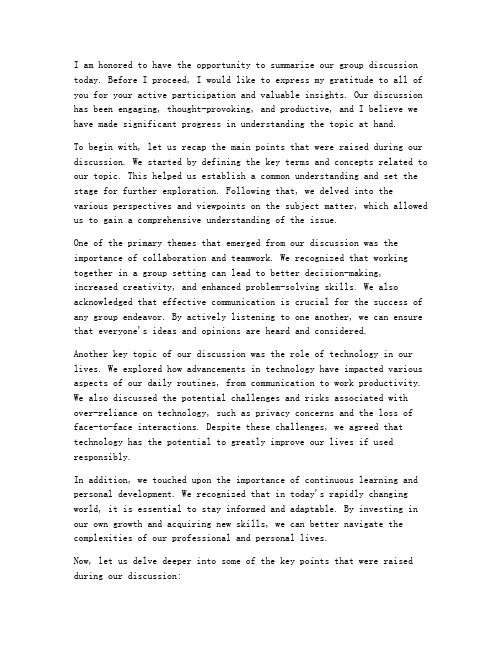
I am honored to have the opportunity to summarize our group discussion today. Before I proceed, I would like to express my gratitude to all of you for your active participation and valuable insights. Our discussion has been engaging, thought-provoking, and productive, and I believe we have made significant progress in understanding the topic at hand.To begin with, let us recap the main points that were raised during our discussion. We started by defining the key terms and concepts related to our topic. This helped us establish a common understanding and set the stage for further exploration. Following that, we delved into the various perspectives and viewpoints on the subject matter, which allowed us to gain a comprehensive understanding of the issue.One of the primary themes that emerged from our discussion was the importance of collaboration and teamwork. We recognized that working together in a group setting can lead to better decision-making, increased creativity, and enhanced problem-solving skills. We also acknowledged that effective communication is crucial for the success of any group endeavor. By actively listening to one another, we can ensure that everyone's ideas and opinions are heard and considered.Another key topic of our discussion was the role of technology in our lives. We explored how advancements in technology have impacted various aspects of our daily routines, from communication to work productivity. We also discussed the potential challenges and risks associated with over-reliance on technology, such as privacy concerns and the loss of face-to-face interactions. Despite these challenges, we agreed that technology has the potential to greatly improve our lives if used responsibly.In addition, we touched upon the importance of continuous learning and personal development. We recognized that in today's rapidly changing world, it is essential to stay informed and adaptable. By investing in our own growth and acquiring new skills, we can better navigate the complexities of our professional and personal lives.Now, let us delve deeper into some of the key points that were raised during our discussion:1. The benefits of collaboration and teamwork:We discussed how working together in a group can lead to a more comprehensive and well-rounded approach to problem-solving. By pooling our diverse skills, knowledge, and experiences, we can tackle complex challenges more effectively. We also acknowledged the importance of respecting each other's opinions and fostering a supportive andinclusive group environment.2. The role of technology in our lives:We explored the various ways in which technology has transformed our lives, from social media to smart devices. While we recognized the benefits of these advancements, we also highlighted the need to be mindful of their potential drawbacks. We emphasized the importance of maintaining a healthy balance between our digital and physical lives, and of promoting digital literacy among individuals of all ages.3. Continuous learning and personal development:We discussed the importance of investing in our own growth and acquiring new skills. We recognized that lifelong learning is essential for personal and professional success. By staying informed and adaptable, we can better navigate the challenges and opportunities that arise in our lives.In conclusion, our group discussion today has been an enlightening and enriching experience. We have gained valuable insights into the various aspects of our topic and have developed a deeper understanding of the issues at hand. Here are some key takeaways from our discussion:1. Collaboration and teamwork are crucial for achieving success in any endeavor.2. Technology has the potential to greatly improve our lives, but we must be mindful of its potential drawbacks.3. Continuous learning and personal development are essential for staying adaptable and successful in today's rapidly changing world.As we move forward, I encourage each of us to reflect on the insights gained from our discussion and apply them to our personal and professional lives. Let us strive to foster a culture of collaboration, embrace the benefits of technology, and invest in our own growth and development.Thank you all for your active participation and valuable contributions.I believe that our group has made significant progress today, and I am confident that we will continue to build upon this momentum as we move forward.Thank you.。
小组讨论英语怎么说
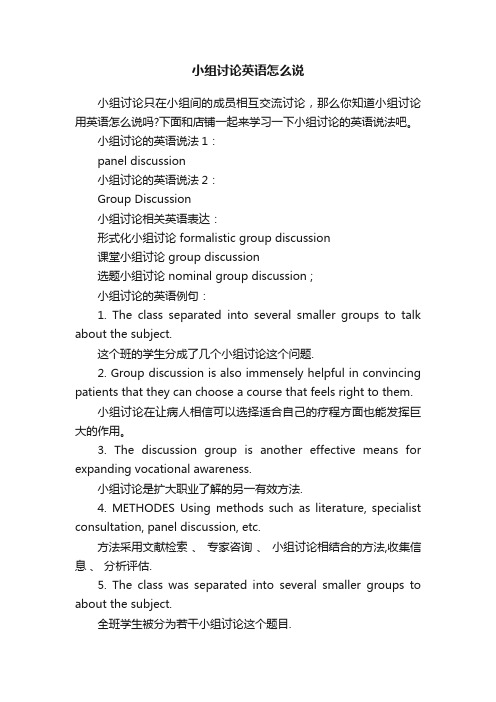
小组讨论英语怎么说小组讨论只在小组间的成员相互交流讨论,那么你知道小组讨论用英语怎么说吗?下面和店铺一起来学习一下小组讨论的英语说法吧。
小组讨论的英语说法1:panel discussion小组讨论的英语说法2:Group Discussion小组讨论相关英语表达:形式化小组讨论 formalistic group discussion课堂小组讨论 group discussion选题小组讨论 nominal group discussion ;小组讨论的英语例句:1. The class separated into several smaller groups to talk about the subject.这个班的学生分成了几个小组讨论这个问题.2. Group discussion is also immensely helpful in convincing patients that they can choose a course that feels right to them.小组讨论在让病人相信可以选择适合自己的疗程方面也能发挥巨大的作用。
3. The discussion group is another effective means for expanding vocational awareness.小组讨论是扩大职业了解的另一有效方法.4. METHODES Using methods such as literature, specialist consultation, panel discussion, etc.方法采用文献检索、专家咨询、小组讨论相结合的方法,收集信息、分析评估.5. The class was separated into several smaller groups to about the subject.全班学生被分为若干小组讨论这个题目.6. A: When are we going to have the group discussion?我们什麽时候要小组讨论?7. We _________ ourselves ________ several groups to discuss our plan.我们分成几个小组讨论我们的计划.8. After listening, can you introduce one of them to the class?小组讨论, 介绍听力材料中的其中一个人物.9. Develop the students'ability to appreciate others'jobs through group discussion.通过小组讨论提高学生的鉴赏能力.10. Advertising campaigns are deeply researched via small discussion groups.通过小组讨论对广告活动进行了深入研究.11. The students divide into several small groups to talk about the subject.学生们分为几个小组讨论那主题.12. Lecturing , case study , role playing , games, test, group discussion.专家讲授、研讨、活动体验、量表测验、小组讨论.13. Essay # 2 due; bring 3 copies for small group workshops; theory handout.8缴交文章 # 2; 带3份复印内容到课堂上给小组讨论工作坊; 理论讲义.14. In group discussions, John is always quick on the trigger.在小组讨论会上, 约翰总是反应敏捷,争先发言.15. Result Medical students accepted the manner of focus group discussions.结果医学生普遍能够接受专题小组讨论的调查形式.。
- 1、下载文档前请自行甄别文档内容的完整性,平台不提供额外的编辑、内容补充、找答案等附加服务。
- 2、"仅部分预览"的文档,不可在线预览部分如存在完整性等问题,可反馈申请退款(可完整预览的文档不适用该条件!)。
- 3、如文档侵犯您的权益,请联系客服反馈,我们会尽快为您处理(人工客服工作时间:9:00-18:30)。
Comments on“Coordination of Groups of MobileAutonomous Agents Using Nearest Neighbor Rules”Dimitri P.Bertsekas and John N.Tsitsiklis Abstract—We clarify the relation between the model and the convergence results of Jadbabaie et al.to those of Bertsekas et al.We show that the up-date equations in Jadbabaie et al.are a special case of those in Bertsekas et al.Furthermore,the main convergence results in Sections II and III of Jad-babaie et al.are essentially the same as those derived earlier in Bertsekas et al.Index Terms—Agreement algorithm,consensus,distributed systems.I.I NTRODUCTIONIn the1980s,[1],[5],and[6]studied various models of distributed asynchronous iterations,motivated by the contexts of parallel compu-tation,distributed optimization,and distributed signal processing.An important“subroutine”in that context was the“agreement algorithm”(see[1,Secs.7.3and7.7]),whereby a set of agents reach consensus on a common value by forming convex combinations of their current values and possibly outdated values possessed by their neighbors.A convergence analysis was provided at the time,including examples de-lineating how convergence to consensus might fail in the absence of certain assumptions on the communication delays,or on the time be-tween consecutive processor communications(see,e.g.,[1,Ex.1.2,p. 485],and[1,Exer.3.1,p.517]).Historically,the idea of reaching consensus through repeated aver-aging was introduced earlier by De Groot[2],for a structured,time-in-variant,and synchronous environment.In the absence of communica-tion delays,convergence conditions for the time-varying case were pro-vided by Chatterjee and Seneta[4],although without making a con-nection between their conditions and more primitive assumptions on the agents’behavior(e.g.,on the frequency of interagent communi-cations,or on the connectivity properties of various graphs describing these communications).From a technical point of view,[2]and[4],as well as subsequent works in this area,were building on a large body of work on Markov chains,ergodicity,and the convergence of products of stochastic matrices.In recent years,several papers have appeared that propose and ana-lyze various consensus algorithms of a similarflavor.The motivation for these works has come from diverse contexts,such as multiagent coordination andflocking.For example,[3]aimed at providing a the-oretical explanation for the observed convergence behavior in an ear-lier simulation study[7]of autonomous agent behavior.Interestingly, however,the resulting mathematical models and questions turned out to be closely related to those in earlier works.As the relation of the more recent works with[1],[5],and[6]has not been sufficiently elu-cidated in the recent literature,we think it is important to clarify it. Rather than attempting a survey paper,aimed at covering the quickly growing recent literature,we will limit ourselves to a discussion of the paper[3],which has received considerable attention and is also most Manuscript received June16,2006;revised October25,2006and January 9,2007.This work was supported by the National Science Foundation under Contract ECS-0312921.The authors are with the Laboratory for Information and Decision Systems, Massachusetts Institute of Technology,Cambridge,MA02139USA(e-mail: dimitrib@;jnt@).Digital Object Identifier10.1109/TAC.2007.895885closely related to our work in[1],[5],and[6].Finally,let us note that[3]contains some additional contributions(a continuous-time variant,a discussion of graph Laplacians,and a discussion of whether conver-gence can be established using a quadratic Lyapunov function).How-ever,these topics are outside the scope of this note.II.T HE M ODEL OF B ERTSEKAS ET AL.Consider a set N=f1;...;n g of agents that try to reach agree-ment on a common scalar value by exchanging tentative values, and combining them by forming convex combinations.In par-ticular,each agent i starts with a scalar value x i(0).The vector x(t)=(x1(t);...;x n(t)),with the values held by the agents at timet,is updated according to the equation x(t+1)=A(t)x(t),where A(t)is a stochastic matrix with entries a ij(t).In more detail,let T ij be the set of times at which agent i receives a message from agent j, containing the value of x j(t),which is used by i to update the value of x i(t).We use the convention that t2T ii for every i and t.The update equation is of the formx i(t+1)=nj=1a ij(t)x j(t);(1)where the coefficients a ij(t)satisfyi)a ij(t) 0,8i,j,t;ii)n j=1a ij(t)=1,8i,t;iii)a ij(t)=0,8i,j,t2T ij.The update(1)corresponds to a simplified version of[5,eqs.(2.1)–(2.4),p.804].The model in[5]is more general along the fol-lowing dimensions:it allows messages to incur delays before reaching their destination,and also allows for an additional exogenous input in the right-hand side of(1).Our formulation involves a subset D of the set of agents.Formally, this can be any subset that happens to satisfy Assumption1below.In-tuitively,it is to be interpreted as a set of agents i for which x i(0)will have a long-term effect on the limit of every x j(t).(The elements of D are called“computing processors”in[5]and“distinguished proces-sors”in[1].)We define E(t)as the set of ordered pairs(j;i)such that a ij(t)>0.Thus,an“edge”(j;i)2E(t)indicates a communica-tion from j to i at time t,that is taken into account when forming the updated value x i(t+1).Accordingly,(N;E(t))is a directed graph in-dicating the influences between agents at time t(the“communication graph”).Let E be the set of(i;j)such that(i;j)2E(t)for infinitely many t.Assumption1:a)The set D is nonempty.b)There is some >0with the following property:if(j;i)2E(t),then a ij(t) .c)There exists some B such that for every t,we have E(t+1)[111[E(t+B)=E.d)The graph(N;E)contains a directed path from every i2D toevery j2N.(In particular,if D=N,then(N;E)is strongly connected.)Assumption1is a special case of[5,Ass.2.1,2.2,and2.4].(The assumptions in[5]are weaker in that they allow for communication delays,and also allow a ii(t)to be zero for certain processors.)Part(c) of Assumption1is a rephrasing of the connectivity assumptions made in[5],which had been stated therein as follows:i)for every i;j,the set T ij is empty or infinite;and ii)if(j;i)2E,then the time between consecutive transmissions from j to i is upper bounded by some B. We now present a convergence result from[5].Theorem 1:There exist nonnegative coef ficients 1;...; n such thatlim t !1x i (t )=nj =1j x j (0)8i;and convergence takes place at the rate of a geometric progression.Furthermore,if j 2D ,then j >0.Theorem 1shows that all x i (t )converge to a common limit,resulting in asymptotic consensus.It is a special case of [5,Lemma 2.1,pp.805–806].(To see this,set all the exogenous driving terms s jl(k )in [5]to zero,and identify j with 8jl (0).)The proof of Lemma 2.1was omitted from [5]as rather straightforward,but can be found in [6].The proof of a special case of Theorem 1was included in Sec.7.3of [1].The proof of Theorem 1(see [6,pp.248–255,App.A])proceedsas follows.Consider the matrix 8(k )=k +nB 01i =kA (i ).Fix a “com-puting processor ”i 32D .Suppose that x i (0)=1and that x j (0)=0for every j =i 3.Let S m =f j j x j (mB )>0g and note that S 0=f i 3g .Note that if a processor ’s value is positive,it remains positive in the future,which implies that S m is a subset of S m +1.If S m =N ,then,by Assumption 1,there is a communication from some j 2S m to some l 2S m ,at some time in the interval f mB;...;(m +1)B 01g .It follows that the cardinality of S m +1exceeds that of S m .This shows that S n =N ,i.e.,x j (nB )>0for all j 2N .It follows that all entries in the i 3th column of 8(0)are positive.A more careful bookkeeping actually shows that all entries of 8(0)are bounded below by some >0that only depends on n and the constant in Assumption 1.More generally,this argument shows that for every k ,the matrix 8(k )“is a stochastic matrix with the property that all entries in some column (corresponding to any computing processor)are positive and bounded away from zero by a constant >0that does not depend on k ”[6,p.253].Using this fact,it is not hard to show (this is a standard argument in Markov chain theory)that t k =18(knB )converges,as t !1,to a matrix with equal rows.This readily implies the convergenceof tk =1A (k )to a matrix with equal rows,i.e.,asymptotic consensus.III.R ELATION W ITH THE M ODEL OF J ADBABAIE ET AL .The model in [3]is the following.At each time t ,there is a set E (t )of edges (i;j ),and each agent i updates a scalar variable i (t )according to (cf.[3,eq.(2)]i (t +1)=11+n i (t)i (t )+j 2N (t )j (t)(2)where N i (t )is the set f j 2N j j =i;(j;i )2E (t )g of “neighbors ”of i ,and n i (t )is the cardinality of N i (t ).Reference [3]assumes an undirected graph,which translates to the following symmetry assump-tion:(i;j )2E (t )if and only if (j;i )2E (t ).Finally,[3]makes the following assumption.(The phrasing of this assumption,in [3,Th.2],is somewhat different,but equivalent to what follows.)Assumption 2:There exists some B such that for every t ,the graph with edge set E (t +1)[111[E (t +B )is strongly connected.Fur-thermore,(i;j )2E (t )if and only if (j;i )2E (t ).It can be seen that (2)is a special case of our iteration (1),with the correspondence D =f 1;...;n g ,x i (t )= i (t )and,a ij (t )=1=(1+n i (t ))for every j =i such that (j;i )2E (t ).Note that our Assumption 1(b)is satis fied with =1=n .Reference [3]establishes convergence to consensus under Assump-tion 2[3,Th.2].Given the previous discussion,this convergence result is a special case of the results in [5](cf.Theorem 1above),except for the difference between Assumptions 1(c)–(d)and Assumption 2.In particular,[5]requires (N;E (t +1)[111[E (t +B ))to be the same strongly connected graph for all t ,whereas [3]allows it to change with t .It turns out that this “same strongly connected graph ”restric-tion is not used in the proof of Theorem 1given in [6].(This should also be clear from the proof outline given above,at the end of Sec-tion II.)The same comments apply to the generalization provided in [3,Sec.II-A],which corresponds to the choice a ij (t )=1=g ,when-ever (j;i )2E (t ),j =i ,and where g is a constant larger than n .Reference [3]then proceeds to consider a variant (“leader fol-lowing ”)in which one of the agents (say,agent 1)never updates its own variable,but indirectly in fluences all of the other agents.This {corresponds}to the model of [5],with D =f 1g .Convergence to consensus on the initial value of agent 1[3,Th.4]is again covered by the results of [5](Theorem 1).Once more,the connectivity assumption in [3]is slightly weaker (in [3],E (t +1)[111[E (t +B )is not required to be the same for all t ),but the convergence proof (the proof of Theorem 1)goes through,unaffected by this weaker assumption.IV .C ONCLUSIONIn summary,the relation between the results in [1],[5],[6]and the convergence results in [3,Secs.II and III]are as follows.a)The update equations in [3]are a special case of the agreement algorithm in [5];the latter allows a more general form of the co-ef ficients a ij (t ),and does not require symmetry in the commu-nication pattern.b)The assumption on the intercommunication time intervals are less stringent in [3],but the proof of the result in [5](as given in [6])still applies.R EFERENCES[1]D.P.Bertsekas and J.N.Tsitsiklis ,Parallel and Distributed Computa-tion:Numerical Methods .Englewood Cliffs,NJ:Prentice-Hall,1989[Online].Available:/1721.1/3719[2]M.H.DeGroot,“Reaching a consensus,”J.Amer.Statist.Assoc.,vol.69,no.345,pp.118–121,1974.[3]A.Jadbabaie,J.Lin,and A.S.Morse,“Coordination of groups ofmobile autonomous agents using nearest neighbor rules,”IEEE Trans.Autom.Control ,vol.48,no.6,pp.988–1001,Jun.2003.[4]S.Chatterjee and E.Seneta,“Towards consensus:Some convergencetheorems on repeated averaging,”J.Appl.Probab.,vol.14,pp.89–97,1977.[5]J.N.Tsitsiklis, D.P.Bertsekas,and M.Athans,“Distributedasynchronous deterministic and stochastic gradient optimization algo-rithms,”IEEE Trans.Autom.Control ,vol.AC-31,no.9,pp.803–812,Sep.1986.[6]J.N.Tsitsiklis,“Problems in decentralized decision making and com-putation ”Ph.D.dissertation,put.Sci.,Mass.Inst.Technol.,Cambridge,MA,1984[Online].Available:/1721.1/15254[7]T.Vicsek,A.Czirok,E.Ben-Jacob,I.Cohen,and O.Schochet,“Noveltype of phase transitions in a system of self-driven particles,”Phys.Rev.Lett.,vol.75,no.6,pp.1226–1229,Aug.1995.。
